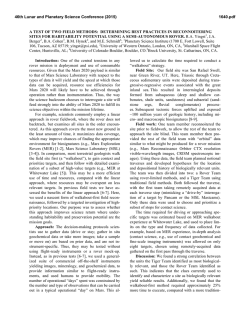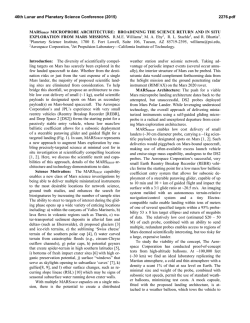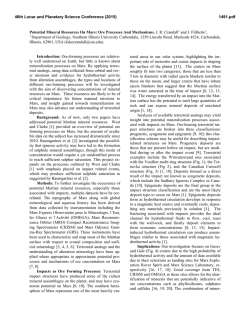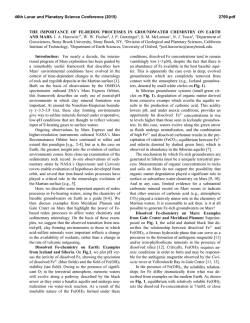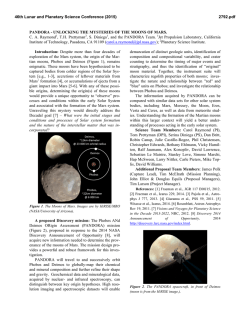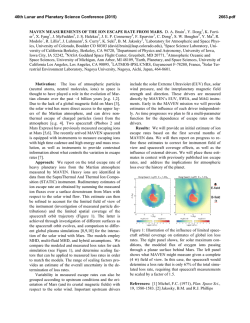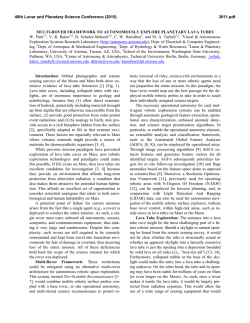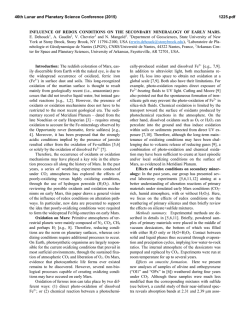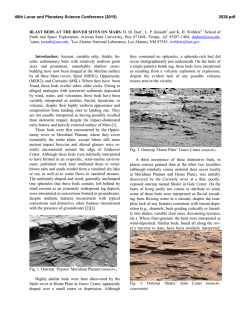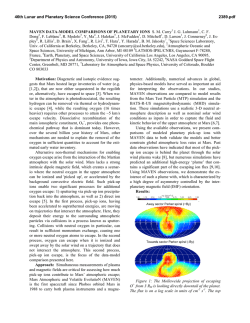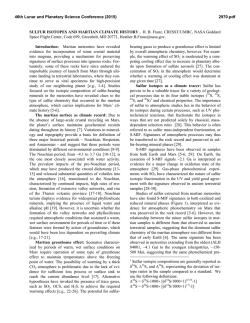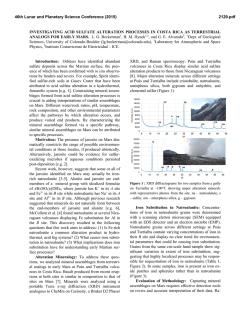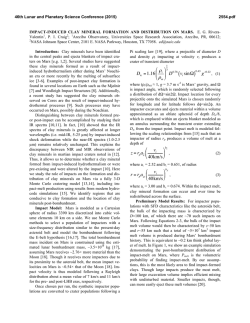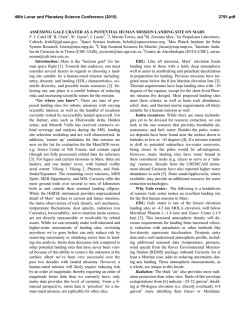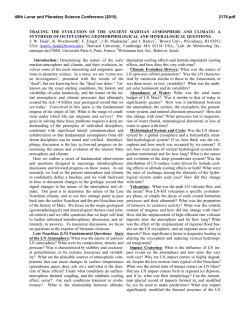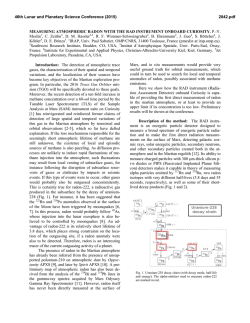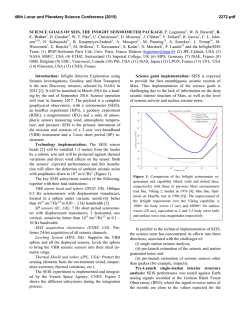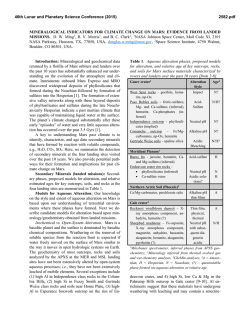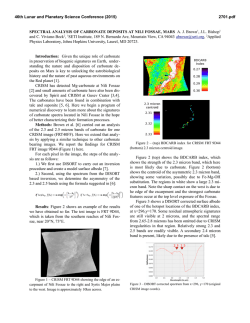
CACHING SCENARIOS FOR THE MARS 2020 ROVER, AND
46th Lunar and Planetary Science Conference (2015) 1672.pdf CACHING SCENARIOS FOR THE MARS 2020 ROVER, AND POSSIBLE IMPLICATIONS FOR THE SCIENCE OF POTENTIAL MARS SAMPLE RETURN. D.W. Beaty1, L.E. Hays1, J. Parrish1, and C. Whetsel1. 1 Mars Program Office, Jet Propulsion Laboratory, California Institute of Technology, Pasadena, CA 91109. ([email protected]). Introduction: A cache is defined (Merriam Webster) as something hidden or stored and preserved in a secure place. In the case of the proposed Mars 2020 sample-collecting rover, its cache has been envisioned as – but is not required to be – a single container into which multiple samples are placed. As part of a program-led study, we have evaluated whether alternate caching implementations might potentially be advantageous to the overall scientific return. It is important to recognize that in order to optimize this decision, science is not the only consideration: additional factors relating to engineering, cost, and risk need to be included, and these can be extremely important. Caching options: A set of four primary caching options has been recognized. 1. Full cache. A container with 31 cells that is carried by the Mars 2020 rover until it is full. 2. Minimum Mission Success cache. A container with 31 cells that is carried by the Mars 2020 rover, and populated with samples until the point that minimum mission success has been declared. For the purpose of comparison, it is assumed that this has about 15-20 samples in it. At this point the cache is off-loaded to the ground, and based on current designs, this would terminate sampling operations. 3. Hybrid cache. A container similar to that described in #2 above, along with a set of single tubes that are delivered to the surface either singly or in groups (see Fig. 1), up to the maximum number of tubes carried on the rover. 4. Adaptable cache. A set of samples, up to the maximum number of tubes carried on the rover, that have been delivered to the surface either singly or in groups, but without a surrounding container. Science elements in common: For the purpose of comparison, the following elements are assumed to be in common across the four caching options. • Mars 2020 would collect scientifically selected samples consistent with Decadal Survey (2011) and Mars 2020 SDT (2013). • Mars 2020 would have a “parking lot” that gives some flexibility before samples are committed into a cache location. • Sample size, shape, encapsulation of individual samples (consistent with E2E-iSAG, 2011 and Mars 2020 SDT, 2013). • A future Mars Ascent Vehicle (MAV) would have a capability to return 31 samples, regardless of what is accomplished by Mars 2020. • The potential exists that Mars 2020 has an extended mission after completion of its prime mission. Implications of the scenarios to science: Our evaluation of the scenarios has shown that there are three major differences, from the perspective of science, of the different scenarios. 1. Effects on individual sample quality. As previously reported by Liu et al. (2014) and Beaty et al. (2014), the quality of samples from Mars can be quantified by 8 parameters (thermal history, inorganic contamination, mechanical integrity, magnetic history, sample gain/loss, preservation of martian chemistry, organic/biological history, and radiation history). For all but one of these parameters, the sample quality would be identical across all of the caching options evaluated. The one potentially significant exception is the temperature history. Individual bare metal sample tubes have the potential to get very hot when laying on the ground in the sun (see Fig. 2). Thermal modelling a cache element Sun TS Sky 4 S 4- A Atmosphere TA Ah s (T C -T A) aS CACHE Figure 1. Example of a sample tube laying on regolith. TS ) TC ( εσ s ApαS α, ε TC As ε σ(T C G(T C -T G) 4- TG 4) Mars Ground TG Ac-‐ • Solar Absorption from Sun Figure 2. Graphic representation of the inputs and • Solar Reflection from ground outputs related• toRadiation thermal modelling to sky and ground of a sample tube Convection to atmosphere on the martian• • surface. Conduction to ground JPL Strategic R&TD FY12 46th Lunar and Planetary Science Conference (2015) 2. Quality of the sample collection. The quality of the collection, as determined by its usefulness to answer scientific questions, differs across the four caching scenarios in the following respects: 2a) Number of Samples. If Mars 2020 were to survive into an extended mission, Scenarios #1, #3, and #4 could all put together 31-sample caches. However, Scenario #2 would be numerically significantly less. 2b) Selectivity of the Samples. The selectivity of the samples in the collection could originate in one of two ways: 1). By the higher the number of options Mars 2020 has to visit sites of interest and to take samples, and 2). By the number of samples the retrieval mission would have to choose from as it loads the MAV. The former selectivity is likely to be manifested largely in the diversity of the collection. This in turn is of high interest to science—the greater the diversity, the broader the array of questions the samples can be used to address. The latter selectivity would likely manifest itself in the design of the sample suites. The elements of a suite (samples that have a defined relationship to each other) can be better chosen once the range of sampling possibilities is known. 2c) Capability to sample a major discovery made late in the mission. The rovers Spirit, Opportunity and Curiosity have all made their most important discoveries during their extended mission phases. In the case of the Mars 2020 sample-collecting rover, there is no assurance that there would be an extended mission. However, by analogy with prior missions, this potential exists, and this potential has high value to science. If the rover survives this long, some of the scenarios might have the ability to continue into the extended mission, and others not. 3. Restrictions on Operations to visiting sampling sites & non-sampling exploration. A significant concern to the operation of the Mars 2020 rover is that if the samples are carried in a container on-board, and samples are progressively added, the value of the cache would steadily increase. The more valuable the cache, the more the rover may face restrictions on its surface operations, including mobility and sampling ops. Some of the scenarios considered provide relief for this in the form of getting the samples off the rover, so that the rover never carries too much of the sample value at any one time. 1672.pdf Summary: By the time of the conference, decisions are expected to have been finalized by NASA on the basic configuration of the Mars 2020 sample cache. The purpose of this presentation will be to convey information about decisions that have been reached, and to seek input from the science community on decisions that are still pending. References: [1] Mars 2020 SDT (2013). MEPAG. [2] McLennan, S.M. et al. (2011). Astrobiology 12: 175-230. [3] Liu et al. (2014), LPSC abs. #1460, (http://www.hou.usra.edu/meetings/lpsc2014/pdf/1460.pdf) [4] Beaty et al. (2014) 8th International Mars Conference, abs. #1208, (http://www.hou.usra.edu/meetings/8thmars2014/pdf/1208.p df)
© Copyright 2025
